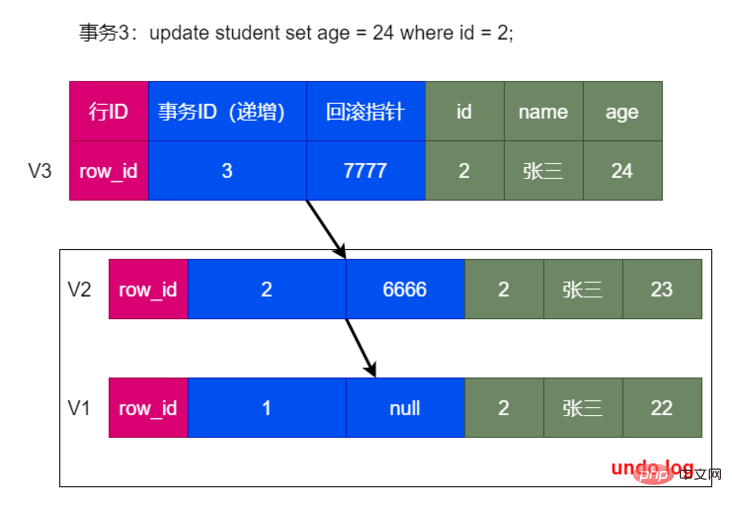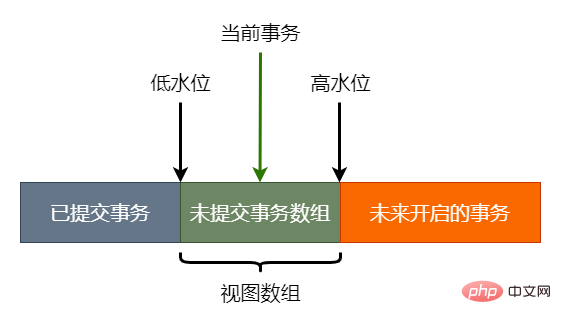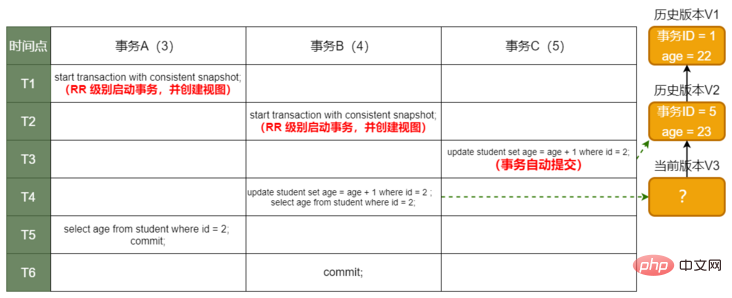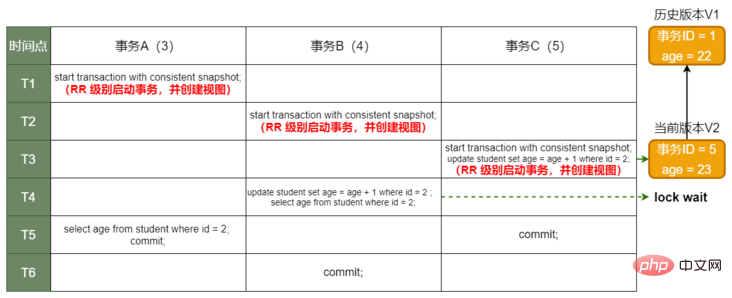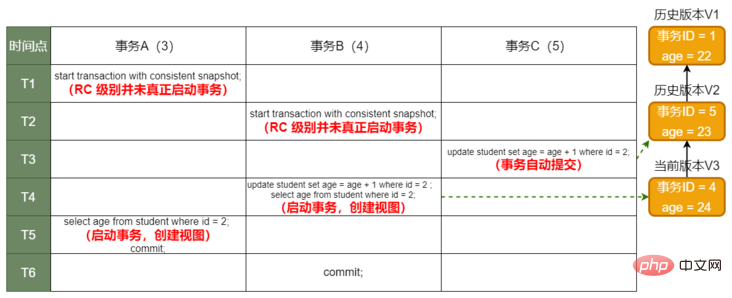 Database
Database
 Mysql Tutorial
Mysql Tutorial
 An article explaining the principles of transactions and MVCC in MySQL in detail
An article explaining the principles of transactions and MVCC in MySQL in detail
An article explaining the principles of transactions and MVCC in MySQL in detail
This article will take you to understand the transactions in MySQL and introduce the principle of MVCC. I hope it can help you!

#01 What is a transaction?
Database transaction refers to a set of data operations. The operations within the transaction are either all successful or all failed. Nothing is done. In fact, it is not that nothing is done. It is possible that some of it is done, but as long as If one step fails, all operations must be rolled back, which is a bit of a non-stop operation.
In MySQL, transaction support is implemented at the engine layer. MySQL is a system that supports multiple engines, but not all engines support transactions. For example, MySQL's native MyISAM engine does not support transactions, which is one of the important reasons why MyISAM was replaced by InnoDB.
1.1 Four major characteristics
- Atomicity: After the transaction starts, all operations are either completed or completed If you don’t do it, you won’t be stuck in the middle. If an error occurs during transaction execution, it will be rolled back to the state before the transaction started, and all operations will be as if they did not happen. That is to say, affairs are an indivisible whole, just like atoms learned in chemistry, which are the basic units of matter.
- Consistency: Before and after the transaction starts and ends, the integrity constraints of the database are not violated. For example, when A transfers money to B, it is impossible for A to deduct the money but B not to receive it.
- Isolation: Only one transaction is allowed to request the same data at the same time, and there is no interference between different transactions. For example, A is withdrawing money from a bank card. B cannot transfer money to this card before A's withdrawal process is completed.
- Durability (Durability): After the transaction is completed, all updates to the database by the transaction will be saved to the database and cannot be rolled back.
1.2 Isolation level
Among the four major characteristics of SQL transactions, atomicity, consistency, and durability are all relatively easy to understand. But the isolation level of transactions is indeed difficult. Today we will mainly talk about the isolation of MySQL transactions.
SQL standard transaction isolation from low to high levels are: read uncommitted (read uncommitted), read committed (read committed), repeatable read (repeatable read) and serializable (serializable) ). The higher the level, the lower the efficiency.
- Read uncommitted: When a transaction has not been committed, the changes it makes can be seen by other transactions.
- Read commit: After a transaction is committed, the changes it makes will be seen by other transactions.
- Repeatable read: The data seen during the execution of a transaction is always consistent with the data seen when the transaction is started. Of course, under the repeatable read isolation level, uncommitted changes are also invisible to other transactions.
- Serialization: As the name implies, for the same row of records, "write" will add a "write lock", and "read" will add a "read lock". When a read-write lock conflict occurs, the transaction accessed later must wait for the completion of the previous transaction before it can continue to execute. So all data under this isolation level is the most stable, but the performance is also the worst.
1.3 Solved concurrency issues
SQL transaction isolation level is designed to solve concurrency issues to the greatest extent:
- Dirty read: Transaction A reads the data updated by transaction B, and then B rolls back the operation, then the data read by A is dirty data
- Non-repeatable read: Transaction A has more When transaction A reads the same data multiple times, transaction B updates and submits the data, resulting in inconsistent results when transaction A reads the same data multiple times.
- Phantom reading: System administrator A changed the grades of all students in the database from specific scores to ABCDE grades, but system administrator B inserted a record of specific scores at this time. When system administrator A After the modification is completed, I find that there is still one record that has not been modified, as if I have hallucinated. This is called phantom reading.
SQL Different transaction isolation levels can solve different concurrency problems, as shown in the following table: Only the serialized isolation level solves all three problems, and the other 3 Each isolation level has flaws.
| Transaction isolation level | Dirty read | Non-repeatable read | Phantom read |
|---|---|---|---|
| Read Uncommitted | Possible | Possible | Possible |
| Read Committed | Impossible | Possible | Possible |
| Repeatable Read | Impossible | impossible | possible |
| impossible | impossible | impossible |
The above is the detailed content of An article explaining the principles of transactions and MVCC in MySQL in detail. For more information, please follow other related articles on the PHP Chinese website!

Hot AI Tools

Undresser.AI Undress
AI-powered app for creating realistic nude photos

AI Clothes Remover
Online AI tool for removing clothes from photos.

Undress AI Tool
Undress images for free

Clothoff.io
AI clothes remover

AI Hentai Generator
Generate AI Hentai for free.

Hot Article

Hot Tools

Notepad++7.3.1
Easy-to-use and free code editor

SublimeText3 Chinese version
Chinese version, very easy to use

Zend Studio 13.0.1
Powerful PHP integrated development environment

Dreamweaver CS6
Visual web development tools

SublimeText3 Mac version
God-level code editing software (SublimeText3)

Hot Topics
 1378
1378
 52
52
 MySQL: Simple Concepts for Easy Learning
Apr 10, 2025 am 09:29 AM
MySQL: Simple Concepts for Easy Learning
Apr 10, 2025 am 09:29 AM
MySQL is an open source relational database management system. 1) Create database and tables: Use the CREATEDATABASE and CREATETABLE commands. 2) Basic operations: INSERT, UPDATE, DELETE and SELECT. 3) Advanced operations: JOIN, subquery and transaction processing. 4) Debugging skills: Check syntax, data type and permissions. 5) Optimization suggestions: Use indexes, avoid SELECT* and use transactions.
 How to open phpmyadmin
Apr 10, 2025 pm 10:51 PM
How to open phpmyadmin
Apr 10, 2025 pm 10:51 PM
You can open phpMyAdmin through the following steps: 1. Log in to the website control panel; 2. Find and click the phpMyAdmin icon; 3. Enter MySQL credentials; 4. Click "Login".
 How to create navicat premium
Apr 09, 2025 am 07:09 AM
How to create navicat premium
Apr 09, 2025 am 07:09 AM
Create a database using Navicat Premium: Connect to the database server and enter the connection parameters. Right-click on the server and select Create Database. Enter the name of the new database and the specified character set and collation. Connect to the new database and create the table in the Object Browser. Right-click on the table and select Insert Data to insert the data.
 How to create a new connection to mysql in navicat
Apr 09, 2025 am 07:21 AM
How to create a new connection to mysql in navicat
Apr 09, 2025 am 07:21 AM
You can create a new MySQL connection in Navicat by following the steps: Open the application and select New Connection (Ctrl N). Select "MySQL" as the connection type. Enter the hostname/IP address, port, username, and password. (Optional) Configure advanced options. Save the connection and enter the connection name.
 MySQL and SQL: Essential Skills for Developers
Apr 10, 2025 am 09:30 AM
MySQL and SQL: Essential Skills for Developers
Apr 10, 2025 am 09:30 AM
MySQL and SQL are essential skills for developers. 1.MySQL is an open source relational database management system, and SQL is the standard language used to manage and operate databases. 2.MySQL supports multiple storage engines through efficient data storage and retrieval functions, and SQL completes complex data operations through simple statements. 3. Examples of usage include basic queries and advanced queries, such as filtering and sorting by condition. 4. Common errors include syntax errors and performance issues, which can be optimized by checking SQL statements and using EXPLAIN commands. 5. Performance optimization techniques include using indexes, avoiding full table scanning, optimizing JOIN operations and improving code readability.
 How to use single threaded redis
Apr 10, 2025 pm 07:12 PM
How to use single threaded redis
Apr 10, 2025 pm 07:12 PM
Redis uses a single threaded architecture to provide high performance, simplicity, and consistency. It utilizes I/O multiplexing, event loops, non-blocking I/O, and shared memory to improve concurrency, but with limitations of concurrency limitations, single point of failure, and unsuitable for write-intensive workloads.
 How to recover data after SQL deletes rows
Apr 09, 2025 pm 12:21 PM
How to recover data after SQL deletes rows
Apr 09, 2025 pm 12:21 PM
Recovering deleted rows directly from the database is usually impossible unless there is a backup or transaction rollback mechanism. Key point: Transaction rollback: Execute ROLLBACK before the transaction is committed to recover data. Backup: Regular backup of the database can be used to quickly restore data. Database snapshot: You can create a read-only copy of the database and restore the data after the data is deleted accidentally. Use DELETE statement with caution: Check the conditions carefully to avoid accidentally deleting data. Use the WHERE clause: explicitly specify the data to be deleted. Use the test environment: Test before performing a DELETE operation.
 MySQL: An Introduction to the World's Most Popular Database
Apr 12, 2025 am 12:18 AM
MySQL: An Introduction to the World's Most Popular Database
Apr 12, 2025 am 12:18 AM
MySQL is an open source relational database management system, mainly used to store and retrieve data quickly and reliably. Its working principle includes client requests, query resolution, execution of queries and return results. Examples of usage include creating tables, inserting and querying data, and advanced features such as JOIN operations. Common errors involve SQL syntax, data types, and permissions, and optimization suggestions include the use of indexes, optimized queries, and partitioning of tables.







